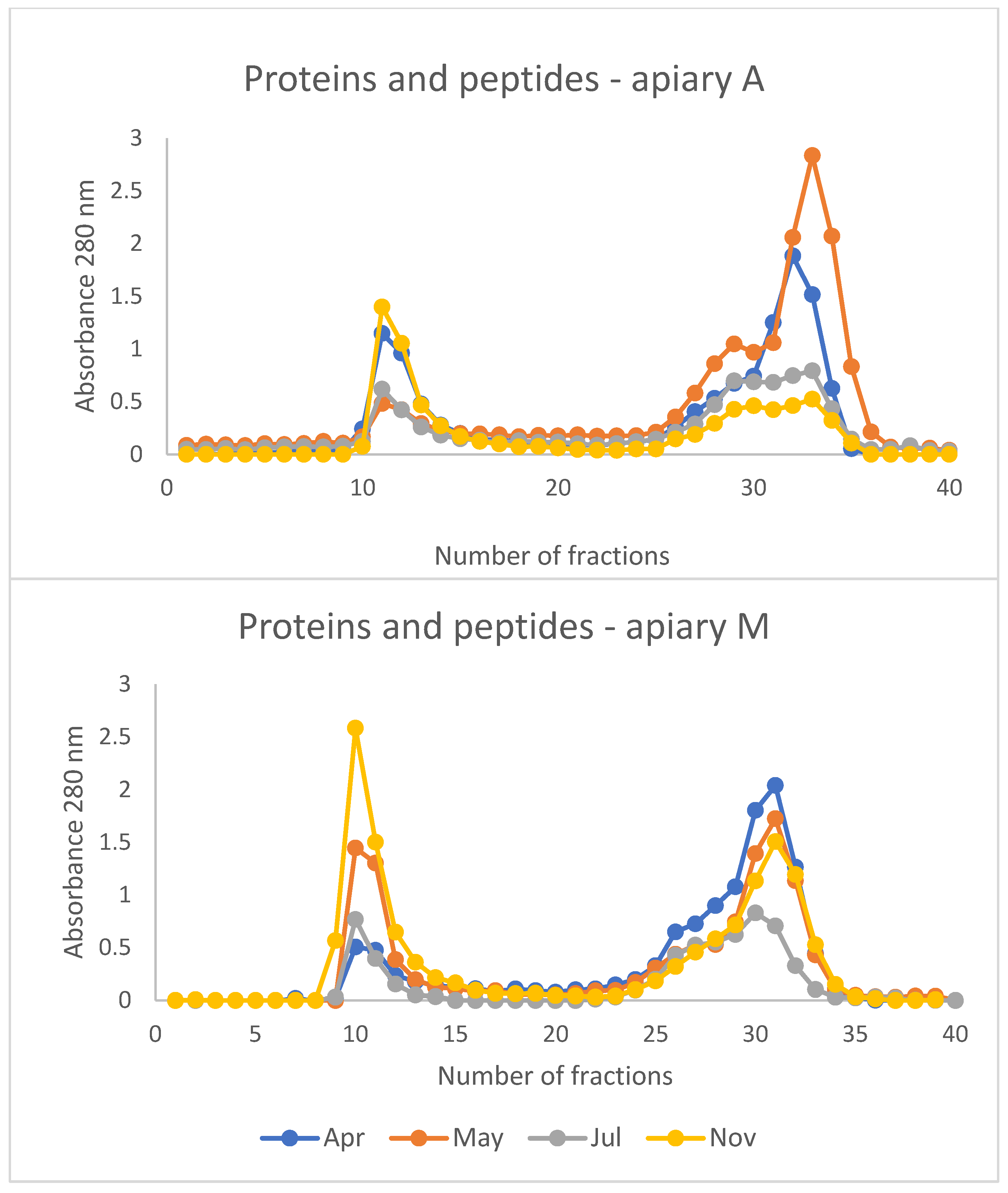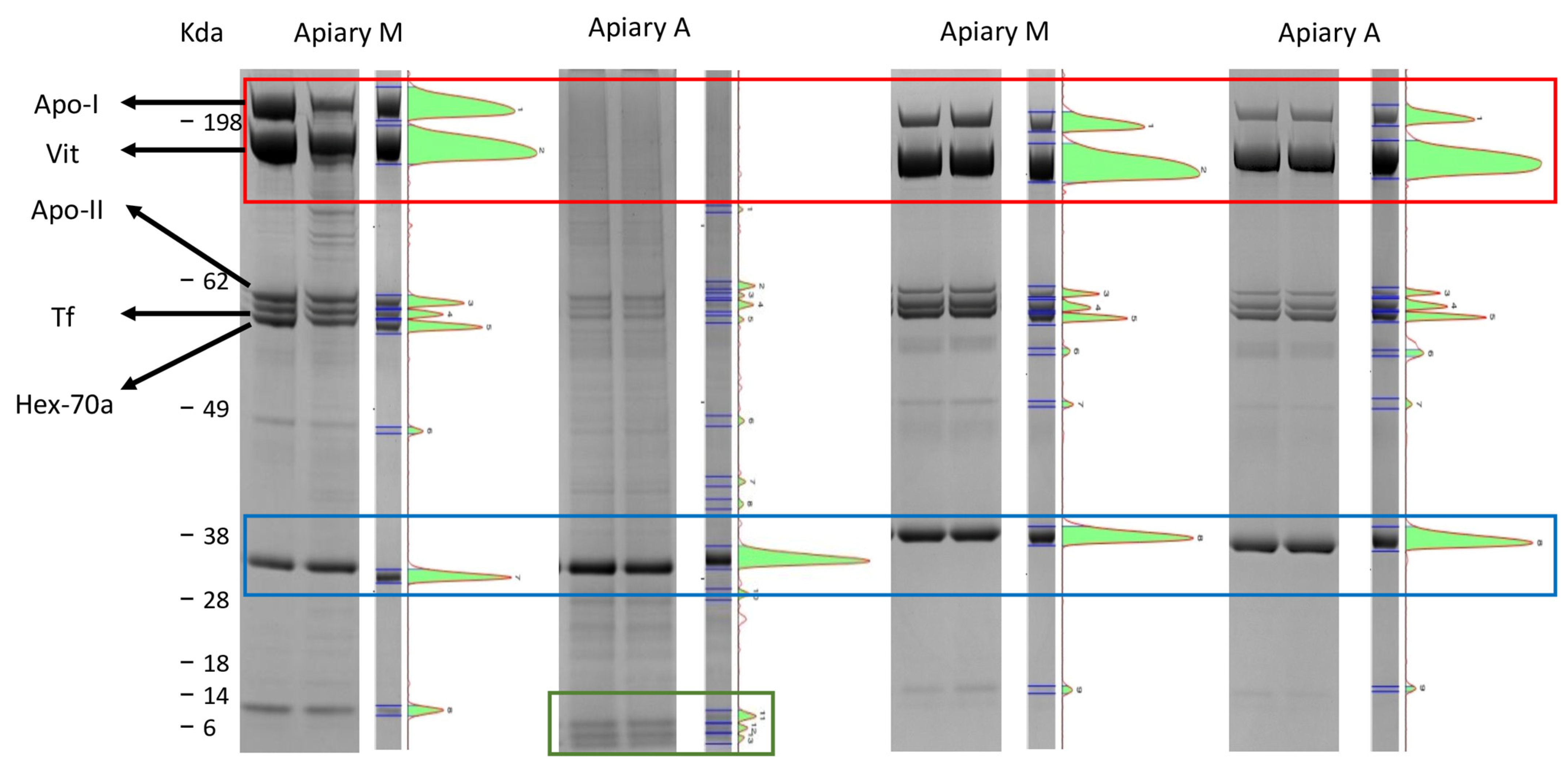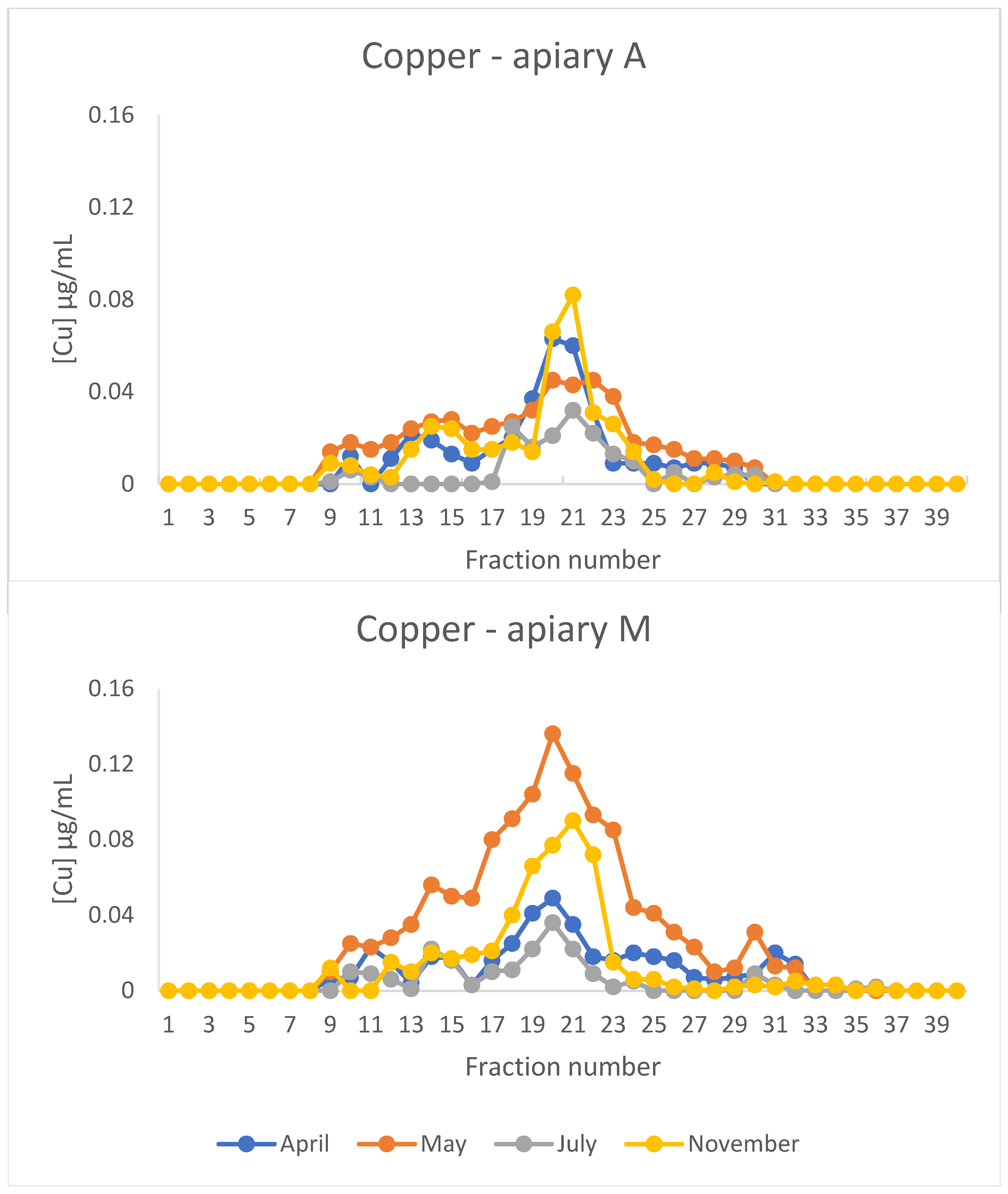An Innovative Multi-Omics Approach Reveals the Interactions Between Honeybees and Their Environment
Simple Summary
Abstract
1. Introduction
2. Materials and Methods
2.1. Experimental Design, Colony Management, and Hemolymph Sampling
2.2. Size Exclusion Chromatography (SEC) of Honeybee Extracts
2.3. Protein Separation Using SDS-PAGE
2.4. Protein Identification by Mass Spectrometry
2.5. Metal Analysis Using Atomic Absorption Spectrometry (AAS)
2.6. Statistical Analysis
3. Results and Discussion
3.1. The Quality of the Environment Affects Honeybee Proteins
3.2. Zinc and Copper Speciation Is Affected by Environmental Factors
4. Conclusions
Supplementary Materials
Author Contributions
Funding
Institutional Review Board Statement
Informed Consent Statement
Data Availability Statement
Acknowledgments
Conflicts of Interest
References
- Ribani, A.; Taurisano, V.; Utzeri, V.J.; Fontanesi, L. Honey Environmental DNA Can Be Used to Detect and Monitor Honey Bee Pests: Development of Methods Useful to Identify Aethina tumida and Galleria mellonella Infestations. Vet. Sci. 2022, 9, 213. [Google Scholar] [CrossRef]
- Askri, D.; Pottier, M.; Arafah, K.; Voisin, S.N.; Hodge, S.; Stout, J.C.; Dominik, C.; Schweiger, O.; Tamburini, G.; Pereira-Peixoto, M.H.; et al. A blood test to monitor bee health across a European network of agricultural sites of different land-use by MALDI BeeTyping mass spectrometry. Sci. Total Environ. 2024, 929, 172239. [Google Scholar] [CrossRef]
- Isani, G.; Bellei, E.; Rudelli, C.; Cabbri, R.; Ferlizza, E.; Andreani, G. SDS-PAGE-Based Quantitative Assay of Hemolymph Proteins in Honeybees: Progress and Prospects for Field Application. Int. J. Mol. Sci. 2023, 24, 10216. [Google Scholar] [CrossRef]
- Rudelli, C.; Galuppi, R.; Cabbri, R.; Dalmonte, T.; Fontanesi, L.; Andreani, G.; Isani, G. Field Application of an Innovative Approach to Assess Honeybee Health and Nutritional Status. Animals 2024, 14, 2183. [Google Scholar] [CrossRef]
- Girotti, S.; Ghini, S.; Ferri, E.; Bolelli, L.; Colombo, R.; Serra, G.; Porrini, C.; Sangiorgi, S. Bioindicators and biomonitoring: Honeybees and hive products as pollution impact assessment tools for the Mediterranean area. Euro-Mediterr. J. Environ. Integr. 2020, 5, 62. [Google Scholar] [CrossRef]
- Mair, K.S.; Irrgeher, J.; Haluza, D. Elucidating the Role of Honey Bees as Biomonitors in Environmental Health Research. Insects 2023, 14, 874. [Google Scholar] [CrossRef]
- Skorbiłowicz, M.; Skorbiłowicz, E.; Cieśluk, I. Bees as Bioindicators of Environmental Pollution with Metals in an Urban Area. J. Ecol. Eng. 2018, 9, 229–234. [Google Scholar] [CrossRef]
- Negri, I.; Mavris, C.; Di Prisco, G.; Caprio, E.; Pellecchia, M. Honey Bees (Apis mellifera, L.) as Active Samplers of Airborne Particulate Matter. PLoS ONE 2015, 10, e0132491. [Google Scholar] [CrossRef]
- Zarić, N.M.; Brodschneider, R.; Goessler, W. Honey bees as biomonitors—Variability in the elemental composition of individual bees. Environ. Res. 2022, 204, 112237. [Google Scholar] [CrossRef] [PubMed]
- Isani, G.; Rudelli, C.; Andreani, G.; Fabbri, M.; Suanno, C.; Parrotta, L.; Del Duca, S. Trace element levels in Italian honeybees and wild plants: Which factors matter? Apidologie 2025, 56, 65. [Google Scholar] [CrossRef]
- Zarić, N.M.; Braeuer, S.; Goessler, W. Arsenic speciation analysis in honey bees for environmental monitoring. J. Hazard. Mater. 2022, 432, 128614. [Google Scholar] [CrossRef]
- Andreani, G.; Ferlizza, E.; Cabbri, R.; Fabbri, M.; Bellei, E.; Isani, G. Essential (Mg, Fe, Zn and Cu) and Non-Essential (Cd and Pb) Elements in Predatory Insects (Vespa crabro and Vespa velutina): A Molecular Perspective. Int. J. Mol. Sci. 2021, 22, 228. [Google Scholar] [CrossRef]
- García-Sevillano, M.A.; Jara-Biedma, R.; López-Barea, J.; González-Fernández, M.; García-Barrera, T.; Pueyo, C.; Gómez-Ariza, J.L. Biological response of free-living mouse Mus spretus from Doñana National Park under environmental stress based on assessment of metal-binding biomolecules by SEC-ICP-MS. Anal. Bioanal. Chem. 2012, 404, 1967–1981. [Google Scholar] [CrossRef]
- BenVau, L.R.; Nieh, J.C. Larval honey bees infected with Nosema ceranae have increased vitellogenin titers as young adults. Sci. Rep. 2017, 7, 14144. [Google Scholar] [CrossRef]
- Bellei, E.; Rustichelli, C.; Bergamini, S.; Monari, E.; Baraldi, C.; Lo Castro, F.; Tomasi, A.; Ferrari, A. Proteomic serum profile in menstrual-related and post menopause migraine. J. Pharm. Biomed. Anal. 2020, 184, 113165. [Google Scholar] [CrossRef]
- Landaverde, R.; Rodriguez, M.T.; Parrella, J.A. Honey Production and Climate Change: Beekeepers’ Perceptions, Farm Adaptation Strategies, and Information Needs. Insects 2023, 14, 493. [Google Scholar] [CrossRef]
- Basualdo, M.; Barragán, S.; Vanagas, L.; García, C.; Solana, H.; Rodríguez, E.; Bedascarrasbure, E. Conversion of High and Low Pollen Protein Diets Into Protein in Worker Honey Bees (Hymenoptera: Apidae). J. Econ. Entomol. 2013, 106, 1553–1558. [Google Scholar] [CrossRef]
- Cabbri, R.; Ferlizza, E.; Nanetti, A.; Monari, E.; Andreani, G.; Galuppi, R.; Isani, G. Biomarkers of nutritional status in honeybee haemolymph: Effects of different biotechnical approaches for Varroa destructor treatment and wintering phase. Apidologie 2018, 49, 606–618. [Google Scholar] [CrossRef]
- Kunc, M.; Dobeš, P.; Hurychová, J.; Vojtek, L.; Poiani, S.B.; Danihlík, J.; Havlík, J.; Titěra, D.; Hyršl, P. The Year of the Honey Bee (Apis mellifera L.) with Respect to Its Physiology and Immunity: A Search for Biochemical Markers of Longevity. Insects 2019, 10, 244. [Google Scholar] [CrossRef]
- Wu, Z.; Zhou, S.; Yang, L.; He, Q. Regulatory Mechanisms of Vitellogenesis in Insects. Front. Cell Dev. Biol. 2021, 8, 593613. [Google Scholar] [CrossRef]
- Ricigliano, V.A.; Cank, K.B.; Todd, D.A.; Knowles, S.L.; Oberlies, N.H. Metabolomics-Guided Comparison of Pollen and Microalgae-Based Artificial Diets in Honey Bees. J. Agric. Food Chem. 2022, 70, 9790–9801. [Google Scholar] [CrossRef]
- Smart, M.D.; Otto, C.R.V.; Lundgren, J.G. Nutritional status of honey bee (Apis mellifera L.) workers across an agricultural land-use gradient. Sci. Rep. 2019, 9, 16252. [Google Scholar] [CrossRef]
- Dostálková, S.; Dobeš, P.; Kunc, M.; Hurychová, J.; Škrabišová, M.; Petřivalský, M.; Titěra, D.; Havlík, J.; Hyršl, P.; Danihlík, J. Winter honeybee (Apis mellifera) populations show greater potential to induce immune responses than summer populations after immune stimuli. J. Exp. Biol. 2020, 224 Pt 3, jeb232595. [Google Scholar] [CrossRef]
- Available online: https://www.arpae.it/it (accessed on 11 December 2024).
- Phillips, B.B.; Shaw, R.F.; Holland, M.J.; Fry, E.L.; Bardgett, R.D.; Bullock, J.M.; Osborne, J.L. Drought reduces floral resources for pollinators. Glob. Change Biol. 2018, 24, 3226–3235. [Google Scholar] [CrossRef]
- Flores, J.M.; Gil-Lebrero, S.; Gámiz, V.; Rodríguez, M.I.; Ortiz, M.A.; Quiles, F.J. Effect of the climate change on honey bee colonies in a temperate Mediterranean zone assessed through remote hive weight monitoring system in conjunction with exhaustive colonies assessment. Sci. Total Environ. 2018, 653, 1111–1119. [Google Scholar] [CrossRef]
- Toth, A.L.; Kantarovich, S.; Meisel, A.F.; Robinson, G.E. Nutritional status influences socially regulated foraging ontogeny in honey bees. J. Exp. Biol. 2005, 208, 4641–4649. [Google Scholar] [CrossRef]
- Toth, A.L.; Robinson, G.E. Worker nutrition and division of labour in honeybees. Anim. Behav. 2005, 69, 427–435. [Google Scholar] [CrossRef]
- Di Pasquale, G.; Salignon, M.; Le Conte, Y.; Belzunces, L.P.; Decourtye, A.; Kretzschmar, A.; Suchail, S.; Brunet, J.-L.; Alaux, C. Influence of Pollen Nutrition on Honey Bee Health: Do Pollen Quality and Diversity Matter? PLoS ONE 2013, 8, e72016. [Google Scholar] [CrossRef]
- Schmidt, J.O.; Thoenes, S.C.; Levin, M.D. Survival of honey bees, Apis mellifera (Hymenoptera: Apidae), fed various pollen sources. Ann. Entomol. Soc. Am. 1987, 80, 176–183. [Google Scholar] [CrossRef]
- Neumann, P.; Straub, L. Beekeeping under climate change. J. Apic. Res. 2023, 62, 963–968. [Google Scholar] [CrossRef]
- McDevitt, J.C.; Gupta, R.A.; Dickinson, S.G.; Martin, P.L.; Rieuthavorn, J.; Freund, A.; Pizzorno, M.C.; Capaldi, E.A.; Rovnyak, D. Methodology for Single Bee and Bee Brain 1H-NMR Metabolomics. Metabolites 2021, 11, 864. [Google Scholar] [CrossRef] [PubMed]
- Isani, G.; Carpenè, E. Metallothioneins, Unconventional Proteins from Unconventional Animals: A Long Journey from Nematodes to Mammals. Biomolecules 2014, 4, 435–457. [Google Scholar] [CrossRef]
- Dallinger, R.; Egg, M.; Köck, G.; Hofer, R. The role of metallothionein in cadmium accumulation of Arctic char (Salvelinus alpinus) from high alpine lakes. Aquat. Toxicol. 1997, 38, 47–66. [Google Scholar] [CrossRef]
- Purać, J.; Nikolić, T.V.; Kojić, D.; Ćelić, A.S.; Plavša, J.J.; Blagojević, D.P.; Petri, E.T. Identification of a metallothionein gene in honey bee Apis mellifera and its expression profile in response to Cd, Cu and Pb exposure. Mol. Ecol. 2019, 28, 731–745. [Google Scholar] [CrossRef]
- Goretti, E.; Pallottini, M.; Rossi, R.; La Porta, G.; Gardi, T.; Goga, B.C.; Elia, A.; Galletti, M.; Moroni, B.; Petroselli, C.; et al. Heavy metal bioaccumulation in honey bee matrix, an indicator to assess the contamination level in terrestrial environments. Environ. Pollut. 2019, 256, 113388. [Google Scholar] [CrossRef]
- Defarge, N.; de Vendômois, J.S.; Séralini, G.E. Toxicity of formulants and heavy metals in glyphosate-based herbicides and other pesticides. Toxicol. Rep. 2018, 5, 156–163. [Google Scholar] [CrossRef] [PubMed]
- Su, C.; Chen, A.; Liang, W.; Xie, W.; Xu, X.; Zhan, X.; Zhang, W.; Peng, C. Copper-based nanomaterials: Opportunities for sustainable agriculture. Sci. Total Environ. 2024, 926, 171948. [Google Scholar] [CrossRef]
- No 2018/848; Regulation (EU) 2018/848 of the European Parliament and of the Council of 30 May 2018 on Organic Production and Labelling of Organic Products and Repealing Council Regulation (EC) No 834/2007. European Commission: Brussels, Belgium, 2018.
- No 2007/834; Council Regulation (EC) No 834/2007 of 28 June 2007 on Organic Production and Labelling of Organic Products and Repealing Regulation (EEC) No 2092/91. European Commission: Brussels, Belgium, 2007.
- Glavan, G.; Benko, G.; Božič, J. Impact of copper and zinc oral chronic exposure on Carniolan honey bee survival and feeding preference. J. Econ. Entomol. 2024, 117, 1485–1492. [Google Scholar] [CrossRef]
- Burden, C.M.; Morgan, M.O.; Hladun, K.R.; Amdam, G.V.; Trumble, J.J.; Smith, B.H. Acute sublethal exposure to toxic heavy metals alters honey bee (Apis mellifera) feeding behavior. Sci. Rep. 2019, 9, 4253. [Google Scholar] [CrossRef]
- Yiwen, W.; Xiaohan, T.; Chunfeng, Z.; Xiaoyu, Y.; Yaodong, M.; Huanhuan, Q. Genetics of metallothioneins in Drosophila melanogaster. Chemosphere 2021, 288 Pt 2, 132562. [Google Scholar] [CrossRef] [PubMed]




Disclaimer/Publisher’s Note: The statements, opinions and data contained in all publications are solely those of the individual author(s) and contributor(s) and not of MDPI and/or the editor(s). MDPI and/or the editor(s) disclaim responsibility for any injury to people or property resulting from any ideas, methods, instructions or products referred to in the content. |
© 2025 by the authors. Licensee MDPI, Basel, Switzerland. This article is an open access article distributed under the terms and conditions of the Creative Commons Attribution (CC BY) license (https://creativecommons.org/licenses/by/4.0/).
Share and Cite
Rudelli, C.; Bellei, E.; Andreani, G.; Isani, G. An Innovative Multi-Omics Approach Reveals the Interactions Between Honeybees and Their Environment. Animals 2025, 15, 2660. https://doi.org/10.3390/ani15182660
Rudelli C, Bellei E, Andreani G, Isani G. An Innovative Multi-Omics Approach Reveals the Interactions Between Honeybees and Their Environment. Animals. 2025; 15(18):2660. https://doi.org/10.3390/ani15182660
Chicago/Turabian StyleRudelli, Cecilia, Elisa Bellei, Giulia Andreani, and Gloria Isani. 2025. "An Innovative Multi-Omics Approach Reveals the Interactions Between Honeybees and Their Environment" Animals 15, no. 18: 2660. https://doi.org/10.3390/ani15182660
APA StyleRudelli, C., Bellei, E., Andreani, G., & Isani, G. (2025). An Innovative Multi-Omics Approach Reveals the Interactions Between Honeybees and Their Environment. Animals, 15(18), 2660. https://doi.org/10.3390/ani15182660





